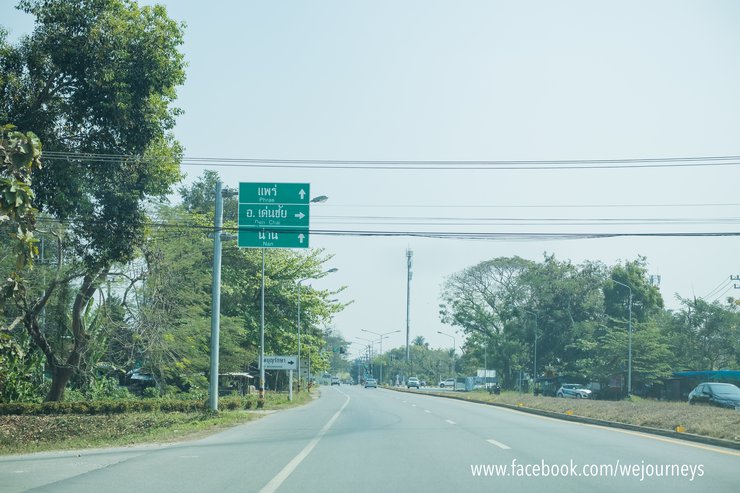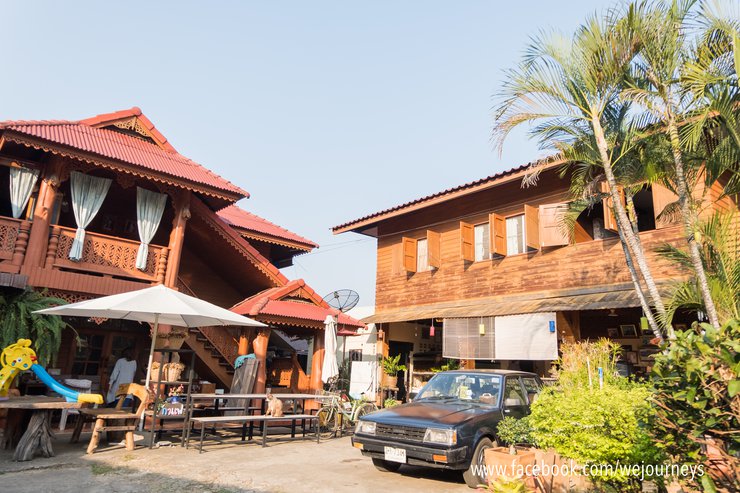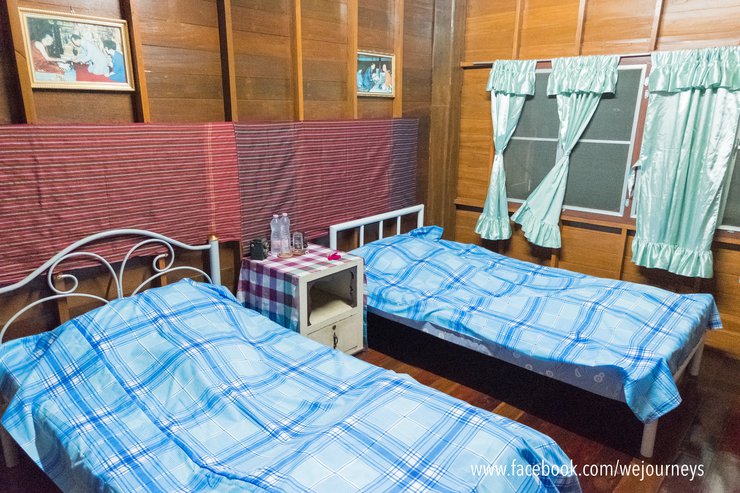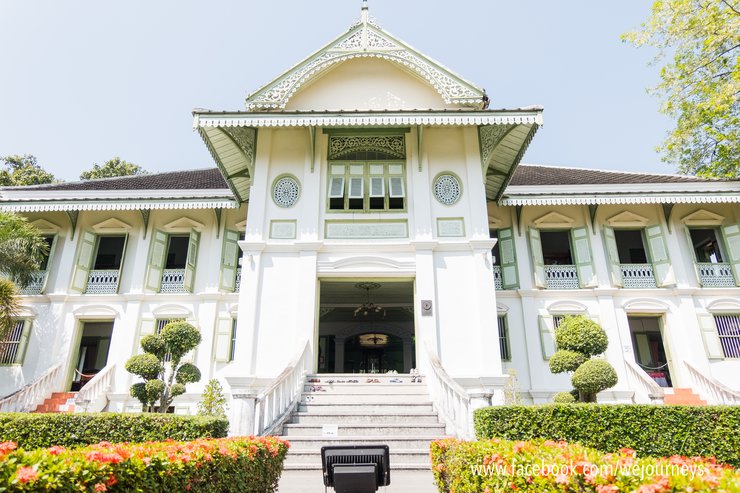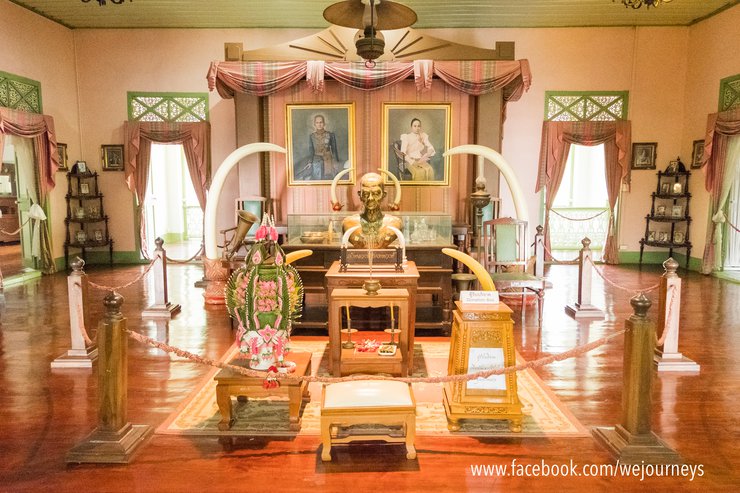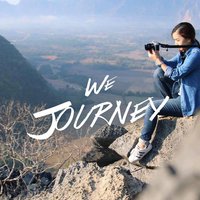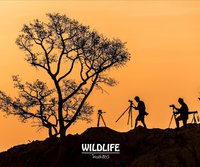"Teakwood mortar, Phra Lo's beloved land, Chae Ha flower, the city's pride,
Famous for the goats of the ghost town, the people of Phrae are kind-hearted."
Yes, that's right! From the motto… This time we have the opportunity to visit Phrae, a city where we can slow down and enjoy the culture, friendly people, and historical and lifestyle attractions.
On this trip, we visited many places, including:
- Khum Chao Luang, Wat Phongsawan, Ban Wongsaburi, Kad Sam Wai
- Wrapped noodle shop, Wat Chom Sawan, Wat Phra That Doi Leng
- Baan Baew Coffee, Tham Pha Nang Khoi, Mae Thang Reservoir
- Ghost Town Goats, Tung Po Teung, Kad Kong Khao, Pratu Chai
- Ban Tung Hong, Kammee Studio, Ha Rae Bomb Coffee Shop, Wat Phra That Chae Ha
With a 3-day, 2-night trip, how much fun can we have? Let's see :)
Follow other photos at^^
Page>> https://www.facebook.com/wejourneys
Instagram>> https://www.instagram.com/ou.wejourney/
Day 1
We started our journey at 8:30 am by car from Chiang Mai. We took Highway 11 and turned onto Highway 1023 through Long District. Then we drove for about 2.5 hours and arrived in Phrae City.

We checked in to our accommodation, Chatawan Homestay, which we had booked in advance. The price was 400 baht per night (including breakfast). The owner, a friendly and kind lady, even recommended tourist attractions in Phrae for us.


After checking in, it was time to hit the road. Our first stop was the "Khum Chao Luang," which is located about 900 meters from our accommodation.

The Khun Luang Residence, originally the residence of the Governor of Phrae Province, was built in 1892 by the last ruler of Phrae, Chao Luang Phiriyathepwong. The residence is a blend of Thai and European architecture, a popular style during the early reign of King Rama V, also known as gingerbread architecture. Admission is free.

The interior of the Lord's Residence has been converted into a museum, showcasing the chambers of Lord Phiphatthepphawong, the guest room, the dining room, historical artifacts, and scale models of various locations in Phrae.






The place is quite lively today as there are many students on a field trip.

After exploring the surrounding area, before leaving, we stopped by the basement of the Lord's Residence, which used to be an underground prison. **People from Phrae might already know that we should enter this gate by walking backward because it is the gate of the ghosts. Ordinary people cannot enter because they might encounter mysterious things. (This is a personal belief.)**


The interior atmosphere is rather cool and eerie.


After taking photos, we walked to Wat Phong Sunan, which is about 300 meters from the Lord's Palace. Inside the temple, it was decorated with beautiful colored lanterns.


The Ubosot enshrines a 568-year-old Buddha statue in the posture of subduing Mara, known as "Phra Chao Saen Suk." The upper walls are adorned with paintings of the twelve zodiac animals.



The temple grounds are home to a magnificent golden reclining Buddha, a stunning white glass temple with 108 spires, and a beautiful white glass temple.


A short walk away is the "Khum Wongburi or Baan Wongburi", a striking pink building. This house was built in 1897 by Chinese craftsmen from Guangdong province. It is a European-style house, and it was the home of Mae Chao Bua Tha, the first wife of Chao Luang Piriya Thephawong, the last ruler of Nan. It was a gift to her upon her marriage to Chao Sunanta, the daughter of Chao Burirat and Luang Phong. Admission is 30 baht per person.


After admiring the beauty of the surroundings, we went inside to see the interior. The house is decorated with antique belongings of the family that have been passed down for generations, including furniture, silverware, pottery, and important documents.




After leaving Baan Wangburi, we decided to grab a bite to eat. We ended up at a restaurant called "Kway Teow Kong Hor Tong". We arrived around 3 pm, just as the restaurant was about to close. Luckily, we made it just in time!

The unique characteristic of this place is not only the use of banana leaves to wrap the dry noodles, but also the delicious taste that requires no additional seasoning. Each bowl costs 30 baht.

After our meal, we took a stroll through the city, soaking in the atmosphere before heading to the parking lot. From there, we drove to "Wat Chom Sawan," a temple built during the reign of King Rama V. The temple boasts a unique blend of Lanna and Burmese architecture, with its entire structure constructed from teakwood. The multi-tiered roof features nine levels, gradually decreasing in size. This temple was originally built by the Tai Yai people, who migrated from Burma to trade in Phrae. However, following the Tai Yai rebellion in Phrae, the temple was abandoned and fell into disrepair. It was later restored by the Shan people, making it a truly unique and remarkable landmark.

The temple was bustling with local residents who came to pay their respects to the Buddha.


The interior is adorned with stained glass on the ceiling and every pillar, creating a stunning visual effect.


The next stop is Wat Phra That Doi Leng. On the way up to the temple, we passed a coffee shop called Mon Klam Coffee. The sign in front of the shop said it was their first day open, so we decided to stop for a drink and a snack.

The cafe boasts a charming atmosphere with a homey decor. It offers a variety of hot and cold beverages. Seating is available both indoors in an air-conditioned room and outdoors in a garden setting.



After relaxing for a while, it was time to visit the temple. "Wat Phra That Doi Leng" is an ancient temple that is considered an important religious site in Phrae Province.



The panoramic views from the top of this location are breathtaking, offering a tranquil atmosphere with minimal crowds. We opted for an evening visit to capture the stunning sunset.



Before returning to our accommodation, we took a stroll through "Kad Sam Wai," a market renowned for its diverse culinary offerings and local goods. The stage hosted various performances and competitions, while the open space below was furnished with mats and empty khantokes, allowing visitors to purchase food and enjoy it while watching the stage shows. The market operates every Friday.





Day 2
We woke up at seven in the morning and got dressed. We went downstairs, and our aunt had already prepared breakfast for us. It looked delicious!

After lunch, we set off on our journey. We stopped for coffee at "Slope coffee Baan Beowww". "Beow" in the northern language means "slanted". This shop is located on Kham Lu Road, opposite Wat Phongsungnan, the temple we visited yesterday that we couldn't stop by because it was closed.

The most popular spot is to take photos in front of the shop and sip fragrant coffee. Originally, this shop was an old house that was cleverly converted into a charming cafe. There are plenty of relaxing seating areas, both inside the shop and in the garden under the shade of large trees behind the shop.




Our next destination is "Phra Nang Koi Cave", located approximately 36 km from the city center in Rong Kwang district. There are two entrances to the cave: the front entrance, where you can park your car and walk up the stairs to the cave mouth, or the back entrance, where you can drive your car directly to the cave mouth. We chose the convenient option of driving to the back entrance. There is no entrance fee to this cave.


Phra Nang Koei Cave is the most beautiful cave in Phrae Province. Inside the cave, there are many different types of stalactites and stalagmites. The highlight is a rock formation that resembles a woman sitting with her child, waiting for her lover. The locals call this rock Hin Nang Koei, after the legend of the cave.

"The Lady's Waiting Stone"



We walked from the back of the cave to the front entrance.


After exploring the cave, we stopped for lunch at the "Manao Paen Suan Kooma" restaurant, located near the Phana Nang Khoi Cave.

Nestled amidst lush greenery, this restaurant offers a tranquil ambiance with a view of the mountains and a refreshing stream. The air is crisp and clean, and the food is delicious.



Next, we arrived at the "Mae Thang Reservoir," where the atmosphere was cool and comfortable, surrounded by lush green mountains.



Driving into the dam, there are several restaurants on rafts. However, we did not stop because we had already eaten. We went for a walk and took pictures near the dam crest and sat down to enjoy the view for a while.



We continued our journey to the Pae Muang Phi. Before entering, we stopped for dinner at a restaurant in front. They offered a variety of dishes, including made-to-order meals, papaya salad with grilled chicken, and various beverages.

After a satisfying meal, we ventured into the heart of the "Ghost Goat City," a captivating tourist destination within the Pae Muang Phi Forest Park. This geological marvel is a testament to the relentless forces of nature, where sandstone formations have been sculpted into an array of intriguing shapes. The name "Pae Muang Phi" is a combination of two words: "Pae," meaning "thicket," and "Muang Phi," meaning "ghost town," aptly capturing the eerie and desolate atmosphere of the landscape.




The weather here is quite hot during the day, so it is recommended to come in the early morning. Walking up to the top will lead you to a high-angle viewpoint, where you can see the Ghost Town of Goats from a wider perspective.

The sun is setting, and we are heading to the Tung Po Teung flower field in Ban Na Tom, Nam Chom Subdistrict, Sung Men District. This location was recommended by the owner of the homestay where we are staying. It is about a 30-minute drive from the Goat City Ghost. The field officially opened to the public on February 14th and is expected to remain in bloom until around March. When we arrive at the parking lot, local villagers will be waiting with their "sa-leng" vehicles to transport tourists into the field. There is no charge for this service, but visitors are also welcome to walk in if they prefer.

A short ride on a motorcycle taxi brought us to a breathtaking sight: a vast field of sunflowers, their golden petals shimmering under the romantic glow of the setting sun. Tourists flocked to the area, capturing the beauty of the scene with their cameras. If you're eager to witness this stunning spectacle, make sure to visit during this limited window, as it only occurs once a year.







As evening approached, we returned to the city to stroll and find food at the Old Kad Kong. We parked our car at our accommodation and walked a short distance, which was very convenient.


A Charming Saturday Evening Market
Nestled on a street near the front of Wongburi House, this vibrant market unfolds every Saturday evening. It offers a delightful array of local delicacies, souvenirs, and beautiful clothing, all amidst a captivating atmosphere.




Day 3
We checked out of our accommodation at 8:30 am and headed to the Victory Gate. In the early morning, locals gather to offer alms, shop at the fresh market, and enjoy a leisurely breakfast of rice porridge and coffee while soaking in the relaxed atmosphere of Phrae.





Our next stop is "Ban Tung Hong", a 5 km drive from the Victory Monument. This village is famous for its "Mo Hom" fabric and is a popular spot for souvenirs in Phrae. You can find a variety of items here, including naturally dyed and chemically dyed Mo Hom shirts, natural cotton fabrics, and tie-dye t-shirts. The vendors here are very friendly and welcoming.



After browsing through the adorable clothes, we were inspired to try tie-dyeing ourselves. We asked around and found a place that teaches tie-dyeing: "Aunt Ngiam's House," a community learning center for indigo dyeing.


This location offers tourists the opportunity to try their hand at tie-dyeing, with a variety of items available, including shirts, pants, and even handkerchiefs. All the necessary materials and equipment are provided, making it an affordable and accessible experience for visitors to experiment with tie-dye techniques.

The aunt demonstrated the tie-dyeing technique by dipping the fabric into a pre-prepared indigo dye pot, which was derived from the woad plant itself.


This is another great activity of local innovation, from the Hom plant to the popular tie-dye, and most importantly, each piece is unique in the world.

After enjoying tie-dyeing, we continued our journey to "Khammee Studio", a perfect destination for art enthusiasts. This studio not only offers a variety of ceramic products for sale but also provides pottery classes for those who wish to learn the art of clay sculpting.



For those who enjoy sightseeing, photography, and art appreciation in a lush garden setting, this is a must-visit. Notably, the venue also offers delectable homemade pizzas.


Next, we come to Wat Phra That Cho Hae in Phrae Province. A must-visit is the "Phra That Cho Hae", the city's landmark temple. This ancient temple is centuries old.

The temple is surrounded by an iron fence on all four sides of the main stupa. There are four entrances, each with a Lanna-style castle-like archway. The temple walls are adorned with intricate and beautiful patterns. The stupa itself houses the relics of the Buddha. Notably, the temple also features a "Phra Chao Tan Jai" statue, where people come to pray for their wishes to be granted.



And finally, the last stop on our trip is the "Hae Ra Berd" coffee shop, located in Long District. It's about a 45-minute drive from the temple, conveniently on our way back.

The shop is a wooden house. Inside is a museum about the history of Ban Pin, the Mahakan Explosion procession, artwork, old photos of the community, and photos of past activities in Phrae City.


The beverage menu features "exploding" coffee and cocoa, green tea with makrut lime and lemon, and a smooth and delicious blue lemon yogurt.


After a delicious meal, we headed back.
Thank you to everyone who followed our journey and photos. We'll see you again on our next trip! ◡̈
we journey
Friday, November 8, 2024 4:05 PM




